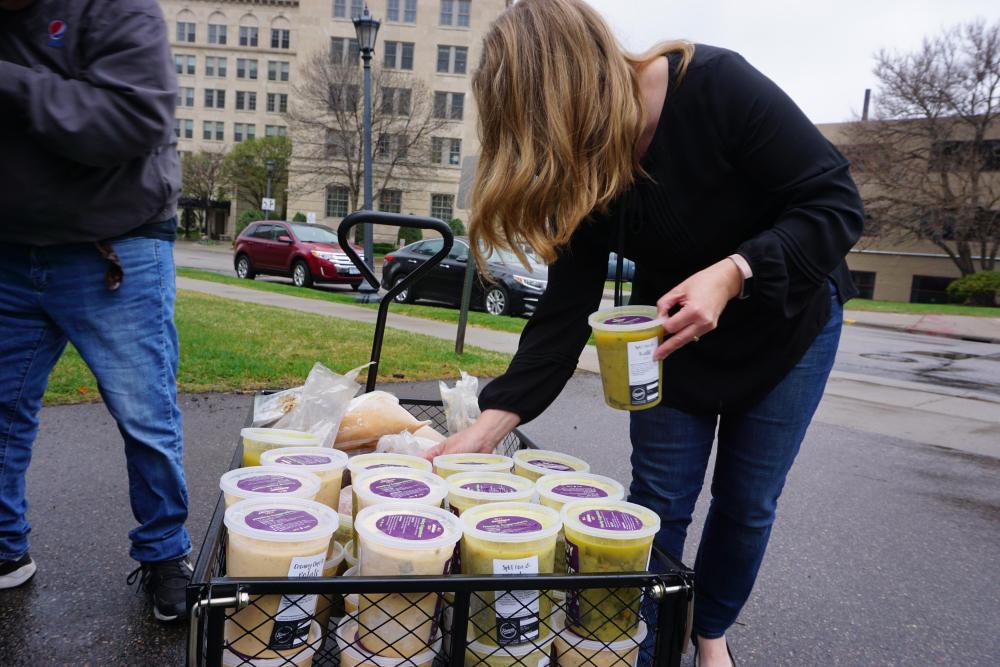
What Does it Mean to Rescue Food?
At least 31 percent of our food supply goes uneaten according to the U.S. Department of Agriculture, and discarded food makes up the single largest source of material in our landfills according to the Environmental Protection Agency.
Because much of this food is perfectly good and safe for consumption, it could otherwise transform into meals for those facing hunger in our communities. That’s why as a food bank, we center much of our operations around retail food rescue.
Rescuing food is a win-win-win-win for retailers, for the environment, and for communities in need. But it’s also one that requires regulatory incentives and local investment, making it one of our public policy priorities.
Food rescue in a food bank setting
When produce, bakery, and other perishable items no longer meet grocery store standards, they’re pulled from shelves and collected for donation to local food shelves. Since grocery stores aren’t in the business of food donation, and many local food shelves don’t have the staff or volunteers to conduct outreach to retailers, food banks like Second Harvest Heartland step in to run logistics.
Second Harvest Heartland maintains relationships with area retailers, serving as a centralized point of contact for donation questions, and offering required food safety training so that items are properly collected and donated. Our fleet of trucks pick up and deliver items directly to food shelves or to our warehouse for repackaging. We also facilitate relationships directly between our partners and retailers, with 61% of rescued food picked up from donors by their local food shelf, which is most efficient, keeps food within local communities, and brings fresh food to food shelves and clients fastest. In 2020, 38.5 million pounds of food were donated to Second Harvest Heartland from partners like Lunds & Byerlys, Cub Foods, Target, Walmart…more than 500 stores in total.
The benefit of rescued food for communities
As mentioned, rescuing food, and reducing food waste more broadly, can bring many environmental, economic, and social benefits. ReFED has mapped 27 of the best opportunities to reduce food waste, sortable by financial benefit, waste diversion, emission reduction, water reduction, job creation, and meals recovery.
From our perspective as a food bank, food rescue is the only method of reducing food waste that also connects people in need with meals. Not only does that mean millions more healthy, nutritious meals for those in need, but improved impacts on health care costs and education and economic outcomes.
Regulatory incentives and local investment
These benefits do come with some costs, of course, and require policies and funding to facilitate program creation and maintenance, much of which falls to local counties to manage.
The Minnesota Pollution Control Agency requirement for metropolitan counties to divert 75 percent of solid waste from landfills by 2030 along with the Environmental Protection Agency’s Food Recovery Hierarchy help compel state and local governments to act on food rescue. But costs in staff time, partner willingness, and operational funds are barriers to program success.
Confronting these barriers is critical to food rescue success. That’s why we advocate for different models of investment, encourage participation from our food shelf partners, explore capacity building opportunities, and recruit new advocates and counties to join this important work.
What the pandemic has taught us about food rescue
Such a turbulent and unpredictable year has demonstrated the need for and value of financial support from governments. To maintain participation in and benefit from food rescue, we’ll advocate for renewed grant funding from current county partners and seek out new local investments to support the work of our Food Rescue team.
Despite it all, we have maintained food rescue total like those of 2019. This is due in larger part to county support and relationships with all stakeholders involved in food rescue. We’ll work to strengthen existing relationships and seek out new ones, including diversified funding support.
Food rescue is just one program we advocate for in the fight to end hunger:
-
From milk grants and school meals to commodity programs and senior nutrition, read about our advocacy priorities.
-
Follow us on Twitter for hunger-related activity from state and federal policymakers.
-
Add your name to our growing list of hunger-fighting advocates.
